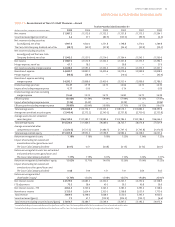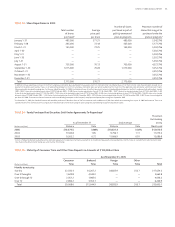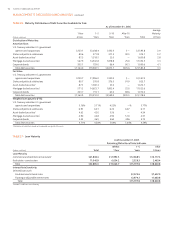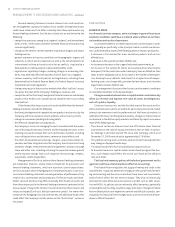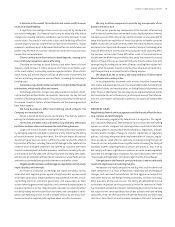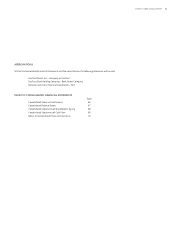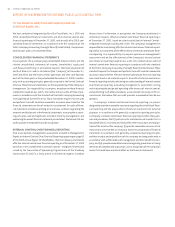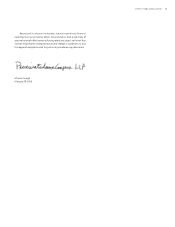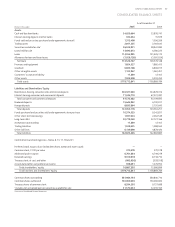SunTrust 2005 Annual Report Download - page 62
Download and view the complete annual report
Please find page 62 of the 2005 SunTrust annual report below. You can navigate through the pages in the report by either clicking on the pages listed below, or by using the keyword search tool below to find specific information within the annual report.SUNTRUST ANNUAL REPORT60
financial holding companies may acquire banks and other financial insti-
tutions. This may significantly change the competitive environment in
which we conduct business. Some of our competitors have greater finan-
cial resources and/or face fewer regulatory constraints. As a result of these
various sources of competition, we could lose business to competitors or be
forced to price products and services on less advantageous terms to retain
or attract clients, either of which would adversely affect our profitability.
Future legislation could harm our competitive position.
Congress occasionally considers proposals to substantially change the
financial institution regulatory system and to expand or contract the powers
of banking institutions and bank holding companies. Such legislation may
change banking statutes and the operating environment in substantial and
unpredictable ways. If enacted, such legislation could increase or decrease
the cost of doing business, limit or expand permissible activities, or affect
the competitive balance among banks, savings associations, credit unions,
and other financial institutions. We cannot predict whether new legislation
will be enacted and, if enacted, the effect that it, or any regulations, would
have on our activities, financial condition, or results of operations.
Maintaining or increasing market share depends on market accep-
tance and regulatory approval of new products and services.
Our success depends, in part, on the ability to adapt products and ser-
vices to evolving industry standards. There is increasing pressure to provide
products and services at lower prices. This can reduce net interest margin
and revenues from fee-based products and services. In addition, the wide-
spread adoption of new technologies could require us to make substantial
capital expenditures to modify or adapt existing products and services or
develop new products and services. We may not be successful in introducing
new products and services in response to industry trends or development in
technology, or those new products may not achieve market acceptance. As
a result, we could lose business, be forced to price products and services on
less advantageous terms to retain or attract clients, or be subject to cost
increases.
The Parent Company’s ability to receive dividends from its subsid-
iaries accounts for most of its revenue and could affect its liquidity and
ability to pay dividends.
The Parent Company is a separate and distinct legal entity from its
subsidiaries. It receives substantially all of its revenue from dividends from
its subsidiaries. These dividends are the principal source of funds to pay
dividends on the Parent Company’s common stock and interest and prin-
cipal on its debt. Various federal and/or state laws and regulations limit the
amount of dividends that our bank and certain of its nonbank subsidiaries
may pay to the Parent Company. Also, the Parent Company’s right to par-
ticipate in a distribution of assets upon a subsidiary’s liquidation or reorga-
nization is subject to the prior claims of the subsidiary’s creditors. For more
information, refer to the “Liquidity Risk” section beginning on page and
Note , Capital, to the Consolidated Financial Statements. Limitations on
the Parent Company’s ability to receive dividends from its subsidiaries could
have a material adverse effect on the Parent Company’s liquidity and ability
to pay dividends on common stock.
COMPANY RISKS
We have in the past and may in the future pursue acquisitions, which
could affect costs and from which we may not be able to realize antici-
pated benefits.
We have historically pursued an acquisition strategy, and intend to
continue to seek additional acquisition opportunities. We may not be able
to successfully identify suitable candidates, negotiate appropriate acquisi-
tion terms, complete proposed acquisitions, successfully integrate acquired
businesses into the existing operations, or expand into new markets. Once
integrated, acquired operations may not achieve levels of revenues, prof-
itability, or productivity comparable with those achieved by our existing
operations, or otherwise perform as expected.
Acquisitions involve numerous risks, including difficulties in the
integration of the operations, technologies, services and products of the
acquired companies, and the diversion of management’s attention from
other business concerns. We may not properly ascertain all such risks prior
to an acquisition or prior to such a risk impacting us while integrating an
acquired company. As a result, difficulties encountered with acquisitions
could have a material adverse effect on the business, financial condition,
and results of operations.
Furthermore, we must generally receive federal regulatory approval
before we can acquire a bank or bank holding company. In determining
whether to approve a proposed bank acquisition, federal bank regulators
will consider, among other factors, the effect of the acquisition on competi-
tion, financial condition, future prospects, including current and projected
capital levels, the competence, experience, and integrity of management,
compliance with laws and regulations, the convenience and needs of the
communities to be served, including the acquiring institution’s record of
compliance under the Community Reinvestment Act, and the effective-
ness of the acquiring institution in combating money laundering activities.
In addition, we cannot be certain when or if, or on what terms and condi-
tions, any required regulatory approvals will be granted. Consequently, we
might be required to sell portions of the acquired institution as a condi-
tion to receiving regulatory approval or we may not obtain regulatory
approval for a proposed acquisition on acceptable terms or at all, in which
case we would not be able to complete the acquisition despite the time and
expenses invested in pursuing it.
We depend on the expertise of key personnel. If these individuals
leave or change their roles without effective replacements, operations
may suffer.
The success of our business to date has been, and the continuing suc-
cess will be, dependent to a large degree on the continued services of execu-
tive officers, especially the Chairman and Chief Executive Officer, L. Phillip
Humann, and other key personnel who have extensive experience in the
industry. We do not carry key person life insurance on any of the executive
officers or other key personnel. If we lose the services of any of these inte-
gral personnel and fail to manage a smooth transition to new personnel, the
business could be impacted.
MANAGEMENT’S DISCUSSION AND ANALYSIS continued





